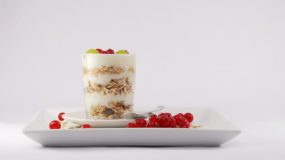Many parents are looking for an exciting activity for their children, which will serve as good entertainment and will benefit. And among the available variety - modeling from plasticine at home takes far from the last place.
This activity develops kids and serves as an excellent basis for the implementation of children's creative ideas. The results of a recent study clearly demonstrated that when sculpting, the main areas of the brain are activated.
With inspiration and time, you can create anything from this material. It is important that the working material does not include harmful dyes and additives. Such components are present in almost all products offered by domestic and foreign manufacturers. That's why parents are interested in the intricacies of making homemade plasticine.
Such a plastic mass has a number of advantages in comparison with purchased products.
- Homemade plasticine is safe, because in the manufacture of substances harmless to children and natural dyes are used.
- Home-made material has a soft and delicate structure, it does not need to be kneaded for a long time, which makes manipulations less time-consuming.
- Often, kids taste what falls into their hands. Citric acid and salt in the composition quickly discourages the desire to eat a "novelty."
- Plasticine created at home does not stick to hands, does not leave a stain and is easily washed off with water.
In addition to the advantages listed above, modeling material has one more advantage. We are talking about the availability and low cost of the materials used. And the creation process itself brings a lot of fun.
Step-by-step recipes for homemade plasticine

At home, the material is made from food products from the kitchen: vegetable oil, flour, salt, starch, citric acid and food coloring. If you need an unusual texture, glycerin, sodium tetraborate, foam balls and even sparkles are added to the composition, as for lizun.
Thanks to the efforts of enthusiasts and experimenters, many types of homemade plasticine have appeared. Some recipes are based on cold cooking technology, others are based on heat treatment.
In any case, homemade plasticine is an elastic mass that resembles dough in structure and properties. Therefore, consider a recipe that is popularly called "salty."
Classic recipe
- Water - 1 cup;
- Flour - 1 glass;
- Fine salt - 0.5 cups;
- Lemon juice - 2 tablespoons;
- Vegetable oil - 2 tablespoons;
- Food colorings.
Manufacture:
- Squeeze lemon juice into a glass, add water, mix.
- Pour salt into the flour. Put the resulting mixture into a pan or pan with a thickened day.
- Pour in vegetable oil, add lemon water and a little dye, mix.
- Hold the mass on the stove for about 5 minutes until it hardens. Remove from heat, cool and mash thoroughly. The material for modeling is ready.
As you can see, homemade plasticine is made quickly and effortlessly. Even if a child, despite an unpleasant taste, swallows a piece of such material, there will be no poisoning.
Alternative recipe
A similar mass is made in the microwave. It differs from the first option only in the materials used and their quantity.
- Water - 2 glasses;
- Flour - 2 glasses;
- Salt - 1 cup;
- Vegetable oil - 1 tablespoon;
- Tartar - 1 tablespoon;
- Dye.
Manufacture:
- Add all of the ingredients listed in the microwave container and mix thoroughly.
- Send the container with elastic mass into the microwave, set the timer for 5 minutes and turn on the device.
- After time, remove the workpiece from the microwave, cool, knead thoroughly and form a ball.
If the child is bored, make homemade plasticine and immerse yourself with him in the atmosphere of creating interesting figures. This lesson will bring a lot of pleasure and leave an unforgettable experience.
How to make smart plasticine

Clever plasticine or handgam is a fascinating toy that takes any shape in dexterous hands. A feature of the material is the ability to change the consistency depending on the applied effort. Even if you divide a small amount into several parts, assembling the pieces into a single whole is not difficult. An indisputable advantage is that it does not get dirty hands, clothes and furniture, because children work with the material.
Such a “miracle” is for sale in toy stores. Some craftsmen make smart plasticine on their own, using the ingredients from the first-aid kit, the components bought in the office or in the hardware store. How to make such an unusual little thing?
The classic recipe for clever plasticine
- PVA glue;
- Sodium tetraborate;
- Food coloring.
Manufacture:
- Squeeze a tube of PVA glue into the container, add dye. The saturation of the shade of smart plasticine depends on the amount of this substance. Mix the composition until a homogeneous mass without streaks and lumps.
- Sodium tetraborate is gradually introduced into the resulting mixture. Note (!), The composition is thickened. Add the powder until the desired consistency is obtained.
- Dip the finished material into the bag and knead thoroughly. The result is a soft and elastic mass.
This method of preparing clever plasticine is very popular, but not every caring mother will give the child a toy whose components do not meet safety and cleanliness standards. Therefore, I propose the second option.
Recipe for Safe Smart Plasticine
An alternative formulation does not involve the use of hazardous components and materials.
- Edible gelatin;
- Plasticine;
- Water;
- Zelenka.
Manufacture:
- Pour 150 ml of water into an aluminum pan, place a container on the stove, turn on the fire. After boiling, add a bag of gelatin to the liquid.
- Stir the contents constantly. When the viscosity of the composition increases, reduce the heat and cook for 5 minutes. Remove the pan from the stove, cool the gelatin base and pour into a plastic container.
- Boil another 100 ml of water in an aluminum bowl and add a few balls made from purchased plasticine. As soon as the “store brother” has melted, wait for cooling and combine both compounds. Add a little green and mix thoroughly.
- It remains only to place the mass in a bag and knead it thoroughly with your hands. A fascinating toy is ready for use in children's creativity.
TIP! If you want your home smart clay to flicker in the sun, add some colorful sparkles to the composition.
What can be made of plasticine

Modeling is a favorite pastime for children. But if this art is easy for kindergarteners and schoolchildren, the smallest children have difficulties. The primary task of parents is to familiarize the child with plasticine. And the following tips will help in this.
- Soft material is suitable for classes. Children’s fingers can cope with the plastic mass without any problems.
- At the initial stage, teach the child to pinch off small pieces.Make grass or raindrop from each such blank.
- To make the baby feel the material, teach it to knead. Let it separate the small pieces and connect, forming a larger lump.
- Rolling out is one of the fundamental tricks. It helps in creating balls, sausages and flagella, from which excellent caterpillars or snowmen are obtained.
- Flattening. Children love this technique. It helps in creating ears for a plasticine animal. This technique is also suitable for sculpting a roof for a house or textured background.
After mastering the listed techniques, proceed to the formation of complex figures and compositions. We are talking about Christmas crafts, holiday gifts and all kinds of decorations. The category of objects includes fairy-tale characters.
Fixies
Consider the instructions for creating Nolik - the main character of the animated film "Fixics". To work, you need a few sticks of plasticine blue, white and blue.
- From the blue mass, mold a rounded blank for the head. Carefully make an eye zone, then squeeze the fossa with the tip of a match.
- Insert the white balls into the recesses, attach the pupils, stick the eyelids. Using the stack, shape the nose and mouth.
- Put a thick cake on the head of Nolik. Cutting and pulling plasticine along the edges, form a hairstyle. Use the blue pieces to shape the crown.
- Make a sausage out of blue plasticine. Fold the resulting element in half. These are the legs. Attach to them contrasting cakes that will serve as shoes. Decorate your shoes with white threads.
- From a round ball of blue color make an elongated torso. Insert a match into the body, attach legs, head and arms to it. From a white droplet, make an emblem on your chest.
HINT! To make the cartoon character realistic, use his photo as a guide. It will help make the figure more detailed.
Useful Tips
In the final part, I will share recommendations on the storage of home plasticine. It will last longer if you follow simple rules.
- Store the mass in the refrigerator, after placing it in a container with a tight-fitting lid.
- A plastic bag will also work.
- To contain multi-colored plates, use a container with partitions or small jars of paint. This will preserve the color and texture of the material.
Homemade plasticine is a godsend for mom who cares about the well-being of the child. Despite its simplicity, it is suitable for modeling, development and everyday play. So sculpt and let the activity bring a lot of joy and benefit.










